|
The purpose of this page is to
compile historical information, reports, tables, and any other
information obtained that may be lost to future LIRR rail researchers. |
|
LIRR Historical Dates List
by Christopher T. Baer |
|
LIRR
Historical Dates List extracted from Christopher T. Baer's:
A General
Chronology of the Pennsylvania Railroad Company Its Predecessors and
Successors and Its Historical Context
July 2008 Edition. Note: All data is subject to future
additions/corrections.
|
|
|
LIRR Car Load Reports
|
LIRR Locomotive Classification |
LIRR Historical Calendar Dates - NRHS LIST |
LIRR
Scheduled Freight Service
|
|
LIRR 1973-1977
Carload Report
LIRR 1977 Carload Report
LIRR 1978 Carload Report
LIRR 1983 Carload Report
LIRR 1985 Carload Report
LIRR 1986 Carload Report
LIRR 1987 Carload Report
LIRR 1988 Carload Report
LIRR 1989 Carload Report
LIRR 1990 Carload Report
LIRR 1991 Carload Report
LIRR 1992 Carload Report
Archives: Jeff Erlitz
|

LIRR Classification Locomotives/Tenders
Form 109-J - 5/15/1948
Archive: Richard Glueck |
LIRR Historical Calendar
Dates - NRHS LIST Long Island Rail
Road
Public Timetables
Archive: Rob Schoenberg - PRR.railfan.net

More
PRR Documents |
LIRR Scheduled Freight Service 8/06/1971
LIRR Scheduled Freight Service 4/07/1975
LIRR Scheduled Freight Service 6/17/1985 |
|
Freight and Yard Switching
Jobs 1948-1968

Click to View |
LIRR Tower Renaming - 1937
Tower
Renaming of 1937
|
LIRR Fleet List 2008
MOE
Dep't - June 30, 2008 |
LIRR Freight and Yard Crew Assignments
LIRR
Freight and Yard Crew Assignments 6/09/1986 |
Book of Rules
LIRR
Book of Rules - Signal Aspects -
7/01/1926
Archive: Dave Keller
|
LIRR Juniata-Altoona Shop Lists
Juniata-Altoona Shop Additions LIRR Lists Archive: Allen Copeland |
LIRR Motive Power History
Steam
History 1898-1955
Dieselization History to 2019
Archive: NRHS-LIST |
|
LIRR Branch Closings |
PRR Record of Transportation Lines - LIRR 1940
LIRR
pages PRR Record of Transportation Lines |
LIRR Passenger and Freight Stations 1955
Extracted PRR Station Index Publication AD 80 |
|
The Manhattan Beach branch shut down in 1924.
The Whitestone branch shut down in 1932.
The Wading River extension and Sag Harbor branch both placed out of
service in 1939. (Last revenue train from Wading River was in Oct, 1938)
The Manorville/Eastport spur shut down in 1949.
The Rockaway Beach branch over Jamaica Bay ended with the fire of 1950 and
trains were routed via Valley Stream and Far Rockaway (Mott Ave.) to
Rockaway Park. Service ended at Far Rockaway (Mott Ave.) in 1955, when
it became part of the NYCTA and the tracks were cut back to Far Rockaway
(Nameoke Ave.).
The Cedarhurst cut-off, Bethpage branch and thru-tracks between Mineola and
West Hempstead/Valley Stream were gone by 1960 although passenger
thru-service ended years earlier.
The Creedmoor branch was gone in 1966 (passenger thru-service ended in 1879
and the branch was only in passenger service between Floral Park and
Creedmoor in the 1880s leaving freight-only service to the state hospital.)
The Old Northport spur was abandoned in 1980 (passenger service ended
decades earlier.) Research: Dave Keller |
LIRR
Passenger and Freight Stations, including staffed passenger
stations, non-agency passenger stops, freight stations (full service
stations and unstaffed (non-agency) sidings), part-time sales agents,
junctions and interchanges revised as of 1/01/1955.
Extracted from PRR Station Index Publication A.D. 80. Archive: Kevin Wong
List of LIRR Interlockings/Block Machines/Control
Panels
LIRR
Interlocking/Block Machines and Local Control and Indication Panels
Research: Jeff Erlitz |
|
CR-4 List of Stations and Sidings
|
General Notices
|
General Orders - Employee Timetables (ETT) |
|
August 1, 1901
July 1, 1903
January 1, 1908
March 1, 1913
September 1, 1919
Montauk Division: Merrick-Bridgehampton
July 1, 1924 Montauk
Division: Islip-Easthampton
September 1, 1944*
October 1, 1948*
Note*: These issues are Modified CR4's and do not, sadly, list all of the sidings any more. It does list all of the stations, yard capacities, floats, and, most importantly, the freight schedules.
It seems they were issued every 4-6 years.
|
General
Notice 2-46
12/05/2016
General Notice 2-47 12/05/2016
General Notice 4-13
7/16/2018
General Notice 4-20
8/27/2018
General Notice 4-21
9/04/2018
General Notice 4-22
9/04/2018
General Notice 4-23
9/10/2018
General
Notice 6-13 7/06/2020
General Notice 6-38
11/30/2020
General Notice 6-70
5/08/2021
General Notice 7-22
10/04/2021
General Notice 7-54
3/26/2022
General Notice 7-64
5/15/2022
General Notice 1-12
8/13/2022
General Notice 1-14
8/29/2022
General Notice 1-21
9/29/2022 |
General Order 401 5/14/2012
General Order 701 6/14/2021
General
Order
701 Appendix A-2
General
Order 702 9/07/2021
General Order 702 Appendix A-2
General Order 703
11/15/2021
General Order 704
3/22/2022
ETT #1-101 5/23/2022
|
|
Speed of Trains - 1905 |
LIRR Locomotive Assignments |
LIRR Track Physical Characteristics c.1960
Track Physical Characteristics c.1960 |
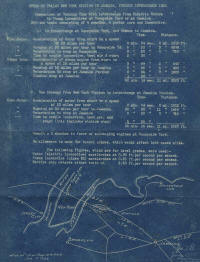
Speed of Trains New York Station to Jamaica, Through Interchange Yard
1/17/1905 - Joseph T. Richard records on Pennsylvania Railroad” collection
at the Hagley Library |

LIRR Locomotive Assignments
6/30/1950 Archive: Richard Adams |
LIRR Physical Characteristics Chronology 2020-2021
Physical
Characteristics Chronology 2020-2021 |
|
LIRR Annual Report - 1914 |

Classification of Freight Traffic
Ohio State University
Digitized by Google |
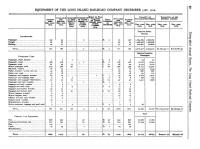
LIRR Equipment, MOW (below)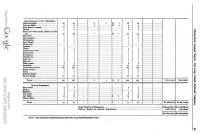
|
LIRR For Sale - Surplus Coaches and Rolling Stock 1990
39
Surplus Coaches
Surplus Rolling Stock Archive: Tim Darnell |
|
|
|
|
Passenger Fare Increases &
Other Historical Dates - 1910-1966 |
|
|
|
|

Passenger Fare Increases and significant date events
Archive: Brad Phillips |
|
|
Information above courtesy of: Jeffery
Erlitz, unless otherwise noted
|
|
LIRR Job Codes |
LIRR Branch Line Colors |
|
YFD = Yard Freight Diesel ex: YFD-201 201 is the crew
assignment number
YPD = Yard Passenger Diesel (crew) [###] (Jamaica storage yard diesel
crews)
YPE = Yard Passenger Electric (Babylon or Jamaica)
YFC = Yard flag condr [###]
RFC = Road flag condr [###]
UB = Utility Brakeman [###]
HMP = Hostler Morris Park - Engineer only
YPR-1 is the “passenger yard” Relief that covers the relief days of the
regular YPD
(Jamaica storage yard diesel crews)
R = Relief
CE = Change engine
The CER-1. Is the relief crew for the Change of Engines or “CE” Jobs
This covers the days off of the regular Change of Engines assignments.
Example on M/T covers CE-1
Wednesday covers CE-2
Th/F covers CE-3 with weekends off.
The CE-2 has Wed/Th off and on Thursday the job is covered by a man off
the extra list (called out)
This is how “relief-regular” jobs are used to cover the scheduled days off
of other regular jobs.
RF = Road Freight outside the Metropolitan Area
RS= Road switcher (NYA)
MA= Metropolitan area local freight or transfer assignments in Brooklyn
and Queens.
YE = Yard Electric
YER “Yard Electric Relief” Such has YER-3 relieves the hillside drills
crews on scheduled days off
GXL = Guarantee Extra List full-time, as opposed to one day, assignment
PROT-## = PROTECT crew. A stand by-be ready to go at a short notice type
of crew.
RSBT-## = Roustabout crew. A do anything crew which maybe not entitled to
some penalty claims as road passenger or road freight crews. These crews
usually shuffle shop trains or other equipment around as required by the
equipment Coordinator throughout their tour of duty.
PASX-## = This call out is usually used when a replacement crew to relieve
a crew from a derailment, fatality, or to go for a whiz quiz’s AKA (drug
test)
COLX-## = Same as above for ticket collector (trainman) assignment as
their independent units jumping from one train to another not part of a
full “Crew” Collectors do not always work the train through from origin to
destination, they get off enroute to work back to where their needed.
NOTE: This title may be used to get a trainman out on a job, so as to not
to guarantee him.
Robert Sturm/Joe Vila |
In Timetable form number order (2022):
Port Washington Branch - scarlet red
Port Jefferson Branch - medium blue
Ronkonkoma Branch - purple
Oyster Bay Branch - lime green
Hempstead Branch - beige
Far Rockaway Branch - brown
Babylon Branch - aqua green
Long Beach Branch - orange
West Hempstead Branch - light blue
City Terminal Zone - gray
Montauk Branch - teal (aqua) Info: Mike McEnaney |
|
The origin of the LIRR Job Codes Listing dates back
to the early 1970’s. At the time, a new department was established to
centralize crew dispatching in a centralized location (1st Floor in
Jamaica Station). Previously there had been different locations to handle
passenger, freight, yard, block operator and engine personal. Each
location was independent and there was a distinct lack of management
(cost) control. I was assigned to develop the new department and to
standardize dispatching protocols.
Although there were printed passenger crew “sheets" for conductors,
brakemen and collectors, the other crafts had no such documents that
described the scope of the individual assignments such as reporting
location, days off, time on duty, etc. A partial remedy to this situation
was the development of the freight and yard crew “sheet”. I used existing
nomenclature where applicable to ease the transition from the old methods
to the new, and descriptive terms where necessary. The codes have
been evolving somewhat as conditions warrant. For instance, flag conductor
listings reflect recent increases in the need to protect major
construction projects as are the assignments to cover drug testing.
Author: Robert Sturm |
|
1866 LIRR Annual Report |
|
|
 |
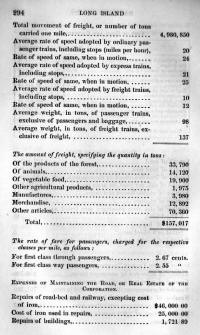 |
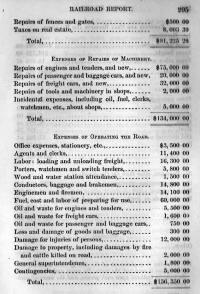 |
|
|
LIRR Official Guide 1971 |
|
List of
Long Island Railroad stations showing distances from Pennsylvania
Station (New York City) and frequency of rail service.
Archive: Kevin Wong |

LIRR Official Guide map 5/01/1971 Archive: Kevin Wong |
|
|
Block Offices/Train Order Offices/Signal Stations |
LIRR Ticket Offices |
|
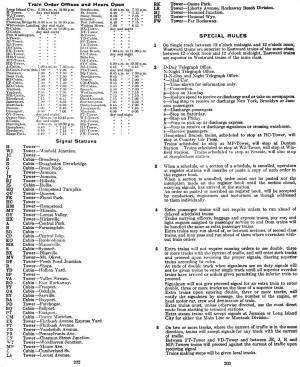
Block Offices/Train Order Offices/Signal Stations open 1916
Archive: Brad Phillips |
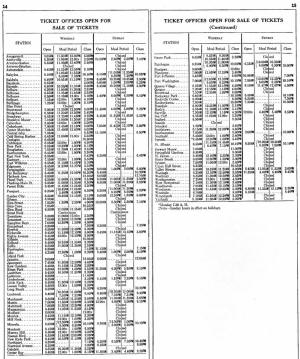
Ticket Office hours open and closed - 1946
Archive: Brad PhillipsLIRR Ticket
Offices 1999
LIRR Ticket
Offices 2015
Compiled: Kevin Wong |

PRR-LIRR
Classification of Cars 1/01/1938 |
|
The 1916 listing is of the hours that Block Offices/Train
Order Offices/Signal Stations are open. Some stations are listed, but
only because the block was handled at those ticket offices. They do not
necessarily mean that ticket sales are available at all those times. While
a block operator could very likely be working in a station ticket office
at the same time that office was open for ticket sales, he may have been
working a later trick (shift) at the station AFTER the ticket office was
closed to ticket sales. A more later-day example of this was Ronkonkoma.
After the ticket office closed, the block operator pulled a shade down
over the large glass ticket window and the trackside bay window so
passengers wouldn't keep bothering him to buy tickets after hours. Info:
Dave Keller |
|
|
On-Time Performance (OTP) Reports |
|

LIRR OTP 2/2015
Archive: Kevin Wong |

LIRR OTP 10/2015
Archive: Kevin Wong |

LIRR OTP 4/2024
Archive: Kevin Wong |
LIRR on-time performance (OTP) reports. In later years the
monthly OTP reports are no longer separated by peak and off-peak. It
should be noted that Far Rockaway, West Hempstead, Port Washington and
Atlantic Branch usually have among the highest on-time rates, month after
month. July, 2022 and all later monthly reports no longer have
separate peak and off-peak OTP data (left). Research: Kevin Wong -
Writer/Historian
|
|
LIRR Saved Collections
|
LIRR Mainline
Timeline History |
|
Queens Borough Public Library, Jamaica, NY
Robert Emery Collection: SUNY Stony Brook, NY
George Brainerd: Brooklyn Public Library
Charles B. Cheney: Smithsonian Institution
Oyster Bay Museum (OBRM) Oyster Bay, NY
Railroad Museum of Long Island (RMLI) Riverhead, NY
PRR Technical Historical Society: Chronology History pages by Christopher T. Baer
A General
Chronology of the Pennsylvania Railroad Company Its Predecessors and
Successors and Its Historical Context
The NRHS National Library in Philadelphia (closed at the end of February 2008 with the contents
placed in a library relocation storage facility) had books, timetables and ephemera from the LIRR.
The collection also included a archive of various Chapter newsletters which included the Long Island
Sunrise Trail Chapter "Semaphore" and the Twin Forks Chapter's own publication which was mailed
to NRHS National as part of the newsletter exchange program that various NRHS chapters had with
one another. Newsletters issued from March 2008 to the present time have been added thanks to a
small group of dedicated NRHS members that chose to continue this archive work.
The stored NRHS Library contents may be either added to a existing transportation library or may
be used to create a new Library facility - the NRHS Library contents may be going to the campus
of Southern Methodist University in Dallas,TX if arrangements can be worked out.
Info: Mike McEnaney
Local libraries and historical societies have material scattered about:
Islip, Great River, and Montauk for example.
|
• The Long Island Rail Road was chartered on April 24,
1834.
• The Brooklyn and Jamaica Railroad was taken over by lease as of April
19, 1836. The LIRR began operations between South Ferry, Brooklyn and
Jamaica that next day.
• The LIRR opened between Jamaica and Hicksville on March 1, 1837.
• Trackage extended from Hicksville to Farmingdale on October 15, 1841.
• Trackage extended from Farmingdale to Central Islip on July 14, 1842.
• The mainline was further opened between Central Islip and Yaphank on
June 26, 1844.
• The mainline was completed between Yaphank and Greenport as of July 27,
1844.
• LI City to Jamaica station, via Woodside, trackage in service on May 9,
1861. Built by the New York and Jamaica Railroad which had been
incorporated on September 3, 1859.
• The Belmont Park Race Track Spur was opened for service on May 4, 1905.
• The mainline from Jamaica to Queens Village and the Belmont Park Spur
electrified on October 2, 1905.
• The mainline between Long Island City and Jamaica via Woodside was
electrified on June 23, 1910.
• The electrification was extended from Queens Village to Mineola during
October 1926.
• The mainline electrification was extended to East Williston on the
Oyster Bay branch during June 1934 to get turning multiple unit trains off
of the mainline in Mineola.
• The mainline was electrified to Hicksville as a part of the Huntington
electrification on October 19, 1970.
• Full Hicksville to Ronkonkoma electrified service began on January 18,
1988.
• September 21, 2018, a project to double track the mainline between
Pinelawn and Ronkonkoma was completed. Earlier in 2016 the second track
between Central Islip and Ronkonkoma was put in service.
• October 3, 2022, a formal opening ceremony for the third mainline track
between Floral Park and Hicksville was held. In 2024 the Long Island Rail
Road mainline is four tracks wide from Penn Station, New York to Queens
Interlocking, three tracks wide from Queens Interlocking to Hicksville,
double track from Hicksville to Ronkonkoma and single track from
Ronkonkoma to Greenport.
Research: Edward M. Koehler, Jr. |
|
Historical question about the
LIRR's reason it came into being:
http://www.trainsarefun.com/lirr/lirr100/lirr100.htm
LIRR 100 Year Anniversary Pamphlet 1934 History
http://www.dunton.org/archive/LongIslandRailroad.htm
History of the Long Island Rail Road by Peter Ross
http://www.trainsarefun.com/lirr/lirrmapexpansion.htm
Bob Andersen LIRR expansion maps
Long Island's geology played a major role in the early
rail lines development. The flat post glacial flood plain in the center of
the Island had no major obstacles to cross, near zero grades and no horse
crossings to deal with. That's why the Pine Barrens was chosen. High speed
all the way to Greenport to get the NY City to Boston traffic. The rail
line and investment was purely to get the NY- Boston traffic. With the ability to bridge the rivers of southern
Connecticut as technology advanced the LIRR link to Boston died.
Info: Steven Lynch |
|
How did the LIRR pick the names for the Parlor
Cars?
They were American Indian names. Since Long Island had a very historical American Indian heritage, many towns were named after Indian tribes or titles. These names were also used, in turn, on the old heavyweight parlors:
Amagansett
Aquabogue
Asharoken
Commack
Copiague
Cutchogue
Jamaica (An American Indian name, not the Caribbean
Island)
Manhasset
Massapequa
Mastic
Matinecock
Mattituck
Merrick
Mineola
Moriches
Nesconset
Noyack
Onteora (an upstate NY Indian name)
Patchogue
Peconic
Quogue
Ronkonkoma
Sagtikos
Setauket
Shinnecock
Teckawitha
Wantagh
Wauwepex means "place of good water".
Wyandanch
In addition to the LI names, there were the upstate NY names, which were taken from the six-nation Iroquois
Confederacy:
Cayuga Club
Mohawk Club
Oneida Club
Onondaga Club
Seneca Club
Tuscarora Club
There were originally 13 tribes on Long Island and they were listed in the old poem:
“The thirteen tribes of common stock
Peopled this isle called Paumanok (Paumanok translated: fish-shaped island)
Before the white man came along
And took it over for a song . . . . “ Research: David Keller
|
|
LIRR Paint Schemes Time Line
ALCO S and RS1s and the Baldwin's were delivered in black
Tichy (All passenger cars, some DD1 electric locos) 11/1/49 to 11/1/52 through 1955
Tichy (Diesels: C-liners arrived in this scheme 1950. 1950-1955 Others were repainted up until 11/1/52)
Tuscan Red with gold Deluxe lettering Until 1940-41 (all passenger cars, loco tenders)
Tuscan Red with gold Futura lettering 1940-41 (some passenger cars, loco tenders)
Tuscan Red with gold Deluxe lettering spaced 1942-1950+ further apart (all passenger cars, loco tenders)
Tichy (all psgr cars, some DD1 electric locos, 1950-1955 some diesel locomotives)
Dark gray with orange (all psgr. cars, diesel 1955-1961 locomotives)
Charcoal gray (Goodfellow gray) (all psgr. cars) 1962-1964
Charcoal gray (Goodfellow gray) with orange nose (diesel locomotives)
Charcoal gray with orange stripe (N.Y. World’s Fair 1964-1968 colors: passenger cars)
Charcoal gray (Goodfellow gray) with orange wave (diesel locomotives)
MTA blue and yellow (diesel locomotives) 1968-1976
MTA Platinum Mist (passenger cars) 1968-end of push-pull service
Research: David Keller
|
|
LIRR Assigned Letters and Numbers to all their
Stations Scheme
The LIRR assigned Letters and Numbers to all their
Stations Scheme; the letters designated the branch. The numbers designated
distance from LI. City.
L23 was L for the Long Beach branch and 23 for 23 miles from L. I. City =
Long Beach station
H21 was H for the Hempstead branch and 21 miles from L. I. City =
Hempstead station
They couldn't use M for Montauk branch because M was used for the
Manhattan Beach branch (Vanderveer Park, located on the Bay Ridge branch,
but originally a station stop on the Manhattan Beach branch) and still in
use as a freight station in the 1950s was still referred to as M-11) and G
(Greenport branch) was used for the Main Line, so they used S for South
Shore, representing the Montauk branch. Hence: S16 was S for the Montauk
branch and 16 for 16 miles from L. I. City = Valley Stream station.
Atlantic branch was A
Bay Ridge branch was B
Belmont Park was Z
Bushwick branch was BU
Central branch was C, which included Garden City (C-20), Island Trees
(C-26) and South Farmingdale (C-29) (Strange about Garden City, because
Stewart Manor was H-16 and Nassau Blvd.
H-17 . . . . Hempstead branch)
Evergreen branch was E
Far Rock branch was F (although Inwood was Z-20!)
Hempstead and West Hempstead (before 1932) branches were "H"
Long Island City was X, a carry over from the days when the main
dispatchers' office at LIC pre-1913 Jamaica was referred to as "X"
Main Line, as mentioned above, was G, however, Jamaica was S-10!
Manhattan Beach branch was M
Oyster Bay branch was O
Port Jefferson/Wading River branch was P
Port Wash branch was N (North Side branch: original name for Port Wash
branch)
Rockaway Beach branch was R
Sunnyside Yard was S
West Hempstead branch was W, after Whitestone branch shut down in
February, 1932. Prior to that the West Hempstead branch stations were
designated "H" although I don't know why, as some of the Hempstead branch
stations were designated "H" yet others were designated "C" for Central
branch.
Whitestone branch was W, until shutdown February 1932
Research: Dave Keller
|















